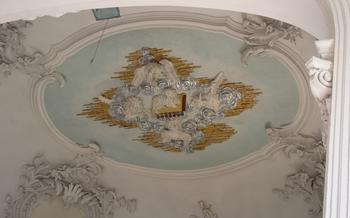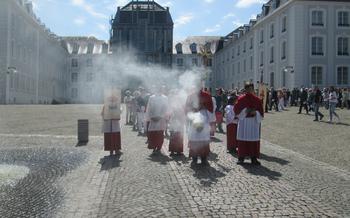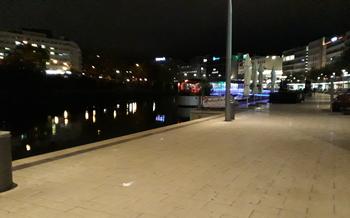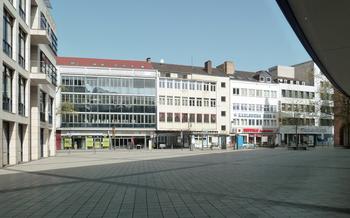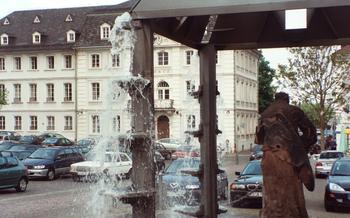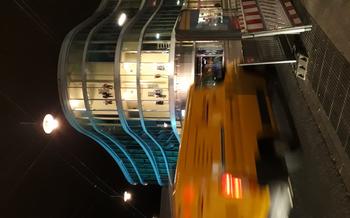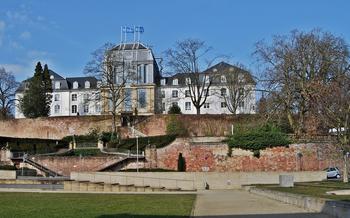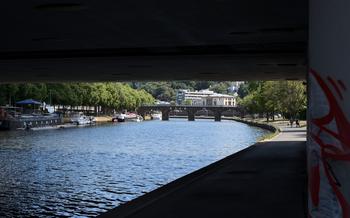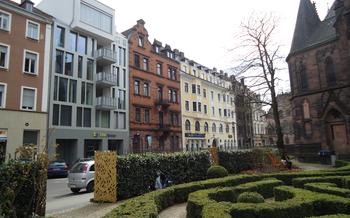
Ludwigskirche
- Ludwigskirche: A Monument to Baroque Grandeur
- Location and Accessibility
- Admire the Neoclassical Facade
- Explore the Rich Interior
- Witness the Magnificence of the High Altar
- Marvel at the Organ's Majestic Sound
- Climb the Tower for Panoramic Views
- Immerse in the History of Saarbrücken
- Attend a Divine Service
- Discover the Work of Local Artists
- Join the Christmas Market Festivities
- Explore the Neighborhood's Hidden Gems
- Capture the Perfect Photo
- Insider Tip: Hidden Details to Look For
Ludwigskirche: A Monument to Baroque Grandeur
The Ludwigskirche, a magnificent Baroque masterpiece, stands as a testament to Saarbrücken's rich history and architectural prowess. Built in the 18th century under the patronage of Prince Ludwig of Nassau-Saarbrücken, this grand edifice not only serves as a spiritual haven but also as a cultural landmark, attracting visitors from far and wide. Its impressive scale, intricate design, and opulent interior make it a must-see destination for anyone exploring the Saarland region.
As you approach the Ludwigskirche, you'll be awed by its sheer size and grandeur. The church's imposing facade, adorned with intricate carvings, sculptures, and a towering spire, sets the tone for the architectural feast that awaits inside. Step through the grand entrance and prepare to be captivated by the harmonious blend of Baroque opulence and neoclassical simplicity that defines this sacred space.
Location and Accessibility
The Ludwigskirche can be found at Ludwigsplatz 15, 66111 Saarbrücken, Germany. It stands proudly in the heart of the city, surrounded by other notable landmarks and vibrant streets. Visitors can effortlessly reach the church using public transportation, with bus stops and tram lines conveniently located nearby. The closest bus stop is Ludwigsplatz, served by lines 102, 103, 104, and 10Alternatively, the Ludwigskirche tram stop is just a short walk away, offering connections via lines 1 and For those arriving by car, several parking options are available in the vicinity of the church. The Ludwigsplatz car park, situated directly opposite the church, provides ample space for visitors.
Visitors with disabilities are warmly welcomed at the Ludwigskirche, with accessible features designed to ensure a comfortable and inclusive experience for all. The church's main entrance is equipped with a wheelchair ramp, allowing easy access for those with mobility challenges. Additionally, designated parking spaces for disabled visitors are available in the Ludwigsplatz car park, ensuring convenient and hassle-free parking.
Admire the Neoclassical Facade
The Ludwigskirche's neoclassical facade is a testament to the architectural grandeur of the 18th century. Its symmetrical lines, towering columns, and intricate pediments create a harmonious and imposing presence. The facade is adorned with an array of sculptures, each representing a biblical figure or allegorical symbol. These sculptures add depth and dynamism to the facade, inviting visitors to contemplate their significance.
The neoclassical style, which originated in the 18th century, was a reaction to the excesses of the Baroque period. It sought to revive the principles of ancient Greek and Roman architecture, emphasizing simplicity, clarity, and proportion. The Ludwigskirche's facade exemplifies these principles, showcasing the restraint and elegance characteristic of neoclassicism.
One notable feature of the facade is its pediment, which features a sculptural group depicting the Assumption of the Virgin Mary. This striking composition symbolizes the Virgin Mary's ascent into heaven, surrounded by angels and cherubs. The pediment serves as a reminder of the church's dedication to the Virgin Mary and adds a touch of divine grandeur to the facade.
The Ludwigskirche's neoclassical facade is not just an architectural masterpiece; it is also a reflection of the city's rich history and cultural heritage. The church stands as a testament to the artistic and intellectual achievements of the 18th century, and its facade continues to inspire and awe visitors to this day.
Explore the Rich Interior
The interior of the Ludwigskirche is a testament to the grandeur and artistry of the Baroque era. As you step inside, your eyes will be drawn to the elaborate frescoes adorning the walls and ceiling. These vibrant paintings depict scenes from the Bible, as well as allegorical representations of faith, hope, and charity. The intricate details and vivid colors of the frescoes create a sense of awe and wonder, transporting visitors back in time.
The church's altar is another masterpiece of Baroque art. Intricately carved from wood and adorned with gold leaf, the altar features a central panel depicting the crucifixion of Jesus Christ. The altar is flanked by two statues, representing the Virgin Mary and John the Baptist. The elaborate carvings and gilding of the altar create a sense of divine majesty, inviting visitors to contemplate the sacredness of the space.
The pulpit, located on the left side of the nave, is another noteworthy feature of the church's interior. Made from carved wood and featuring intricate detailing, the pulpit is a testament to the skill and artistry of the Baroque craftsmen. From this elevated platform, generations of pastors have delivered sermons and shared the word of God with the congregation.
Finally, the church's organ is a masterpiece of both musical and artistic craftsmanship. Built in the 18th century, the organ features over 3,000 pipes and is renowned for its rich and powerful sound. The organ is regularly used for concerts and recitals, filling the church with its majestic melodies.
Witness the Magnificence of the High Altar
The high altar of the Ludwigskirche stands as a testament to the opulence and artistry of the Baroque era. Intricate carvings, sculptures, and gilding adorn its every surface, creating a breathtaking spectacle that draws the eye and inspires awe.
The altar's centerpiece is a grand depiction of the Crucifixion of Jesus Christ, with the Savior's figure rendered in exquisite detail, his body bearing the marks of his sacrifice. Flanking the crucifix are statues of Mary, the Mother of Jesus, and John the Baptist, their faces etched with sorrow and reverence.
The altar's design is a symphony of symbolism, with every element carrying a deeper meaning. The intricate carvings of flowers and foliage represent the eternal life and resurrection promised by Christ's sacrifice. The gilded cherubs and angels symbolize the heavenly host witnessing the sacred event.
In the Baroque era, altars played a central role in religious ceremonies, serving as a focal point for the congregation's devotion and a reminder of the divine presence. The Ludwigskirche's high altar embodies this tradition, inviting visitors to pause, reflect, and connect with the spiritual essence of the church.
Its grandeur and artistry transport visitors back in time, offering a glimpse into the deep faith and devotion that shaped the Baroque period. Whether you are a history buff, an art enthusiast, or simply someone seeking spiritual inspiration, the high altar of the Ludwigskirche is an unforgettable sight that will leave a lasting impression.
Marvel at the Organ's Majestic Sound
The Ludwigskirche's organ is a sight to behold and a sound to cherish. Built by renowned organ builder Daniel Raßmann in 1774, this magnificent instrument boasts 40 stops and over 2,500 pipes, making it one of the largest and most impressive organs in the region. Its ornate facade, intricately carved with cherubs and floral motifs, complements the grandeur of the church's interior.
Regular organ concerts and recitals are held at the Ludwigskirche, allowing visitors to experience the organ's majestic sound firsthand. Renowned organists from around the world grace the church with their performances, filling the air with harmonious melodies that resonate through the centuries-old walls.
In the Baroque era, music played a crucial role in religious ceremonies and worship. The organ's powerful sound was believed to elevate the spirits of the faithful and create an atmosphere of awe and devotion. The Ludwigskirche's organ, with its rich tones and captivating presence, continues to fulfill this purpose, transporting visitors to a realm of spiritual transcendence.
Climb the Tower for Panoramic Views
Visitors who are up for a challenge can ascend the tower of the Ludwigskirche for breathtaking panoramic views of Saarbrücken and the surrounding region. The climb consists of approximately 200 steps, offering a moderate level of difficulty. Once at the top, visitors are rewarded with unparalleled vistas that stretch across the city, showcasing its iconic landmarks, lush green landscapes, and the meandering Saar River. In clear weather, the panoramic views extend far beyond the city limits, providing glimpses of the neighboring countryside and the picturesque Saarland region. Climbing the tower not only offers a unique perspective of the Ludwigskirche but also presents an opportunity to delve into the historical significance of church towers. Traditionally, church towers served as vantage points for spotting fires, alerting the community to potential dangers. They also played a crucial role in religious ceremonies, with bells ringing out to call the faithful to prayer and mark special occasions. By climbing the tower of the Ludwigskirche, visitors gain a deeper appreciation for the church's architectural grandeur and its enduring role in the community.
Immerse in the History of Saarbrücken
The Ludwigskirche holds a profound significance in the tapestry of Saarbrücken's identity. Its history is intricately intertwined with the city's evolution, serving as a silent witness to numerous historical events and milestones. The church's construction was initiated by Count Wilhelm Heinrich von Nassau-Saarbrücken in 1745, reflecting his vision for a resplendent city center. The ruling family's patronage played a crucial role in shaping the church's grandeur and cementing its status as a symbol of power and prestige.
Over the centuries, the Ludwigskirche has borne witness to Saarbrücken's triumphs and tribulations. It stood resilient amidst the devastation of the Second World War, its sturdy structure defying the ravages of bombs. The church's survival is a testament to the indomitable spirit of Saarbrücken's people, who lovingly restored it to its former glory in the postwar years.
Today, the Ludwigskirche stands as a proud symbol of Saarbrücken's rich cultural heritage, a testament to its architectural finesse and spiritual depth. It serves as a reminder of the city's resilience and the enduring legacy of its ruling family. Visitors to the church can immerse themselves in the layers of history etched into its every stone, gaining a deeper appreciation for Saarbrücken's unique identity and its place in the annals of German history.
Attend a Divine Service
Immerse Yourself in the Spiritual Heart of Saarbrücken
For a truly immersive experience, consider attending a divine service at the Ludwigskirche. The church holds regular services throughout the week, allowing visitors to witness the spiritual essence of this sacred space. Services are typically conducted in German, but visitors are welcome to follow along with the provided booklets or simply soak in the atmosphere of devotion.
Before attending a service, it's recommended to arrive early to appreciate the gradual gathering of the congregation and the preparation of the church. Once the service begins, observe the customs and etiquette, such as standing during hymns and bowing during prayers. The service is a blend of traditional liturgy, choral music, and readings from the Bible.
The divine service at Ludwigskirche is not just a religious observance but a communal experience. It's an opportunity to connect with the local community, witness the deep-rooted faith of the Saarbrücken people, and gain a deeper understanding of the church's role in the city's spiritual landscape. Whether you're a practicing Christian or simply curious about religious traditions, attending a service here is a profound experience that will leave a lasting impression.
Discover the Work of Local Artists
The Ludwigskirche has a long history of supporting local artists and showcasing their work. The church regularly hosts exhibitions and art displays featuring paintings, sculptures, and other forms of artistic expression created by talented local artists. These exhibitions provide a platform for local artists to share their unique perspectives and interpretations of the world, while also contributing to the cultural richness of the church and the surrounding community.
Visitors to the Ludwigskirche can immerse themselves in the vibrant local art scene by attending these exhibitions. The works on display often reflect the unique character of Saarbrücken and its people, offering a glimpse into the city's cultural identity. Through these exhibitions, the church not only celebrates the work of local artists but also promotes and supports the development of the local art scene.
Join the Christmas Market Festivities
The Ludwigskirche square transforms into a magical winter wonderland during the annual Christmas market. Wooden stalls adorned with twinkling lights and festive decorations line the square, creating a warm and inviting atmosphere. Visitors can indulge in an array of traditional German delicacies, including gingerbread cookies, mulled wine, and roasted chestnuts. The air is filled with the sweet scent of cinnamon and roasted almonds, inviting passersby to join the festivities.
Local artisans showcase their handmade crafts and unique souvenirs, providing an opportunity to find one-of-a-kind gifts for loved ones. From intricately carved wooden ornaments to delicate glass baubles, there is something for everyone to cherish. The Christmas market at Ludwigskirche square is a celebration of local culture and traditions, bringing the community together in the spirit of joy and giving.
Explore the Neighborhood's Hidden Gems
Beyond the grandeur of the Ludwigskirche, the surrounding neighborhood offers a treasure trove of hidden gems waiting to be discovered. Stroll through the charming streets and uncover historical landmarks, cozy cafes, and unique shops that reflect the city's rich heritage.
For a culinary adventure, head to the nearby Gasthaus Alt Saarbrücken, a traditional German restaurant serving hearty local specialties in a warm and inviting atmosphere. Pair your meal with a refreshing beer from one of the local breweries, such as Karlsberg or Saarfürst.
Explore the world of art and design at the Saarland Museum, just a short walk from the church. This renowned museum showcases a diverse collection of paintings, sculptures, and contemporary art, providing a fascinating glimpse into the region's artistic legacy.
Uncover the city's fascinating history at the Saarbrücken Castle, located on the banks of the Saar River. This majestic fortress dates back to the Middle Ages and offers guided tours that delve into its rich past, including its role as a royal residence and a military stronghold.
For a unique shopping experience, wander through the narrow streets of the Old Town, where you'll find charming boutiques, antique shops, and art galleries. Discover handmade crafts, local delicacies, and one-of-a-kind souvenirs that capture the essence of Saarbrücken.
To fully immerse yourself in the city's vibrant atmosphere, join a guided walking tour or embark on a self-guided exploration. These tours will lead you to hidden courtyards, secret gardens, and lesser-known historical sites, providing a deeper understanding of Saarbrücken's rich tapestry of cultures and traditions.
Capture the Perfect Photo
With its captivating facade, intricate details, and picturesque surroundings, the Ludwigskirche presents a wealth of opportunities for photography enthusiasts. To capture the church's grandeur, position yourself at a slight distance to fully encompass its imposing presence. Experiment with different angles to highlight specific architectural features, such as the towering columns or the delicate sculptures adorning the facade.
For the most dramatic shots, visit the church during the golden hours of dawn or dusk, when the warm light casts a magical glow upon the sandstone exterior. If you're lucky, you might even catch a glimpse of the church bathed in the soft hues of a colorful sunset, creating an unforgettable composition.
Don't forget to explore the church's interior as well. The ornate altar, the intricate frescoes, and the grand organ offer a treasure trove of photographic subjects. Capture the interplay of light and shadow as it dances across the interior, illuminating the rich details of the Baroque masterpiece.
Once you've captured your shots, share them on social media using relevant hashtags like #Ludwigskirche, #Saarbrücken, and #BaroqueArchitecture. Inspire others to discover the beauty of this hidden gem and spread the love for architectural photography.
Insider Tip: Hidden Details to Look For
As you explore the Ludwigskirche, keep an eye out for the intricate carvings, symbols, and inscriptions that adorn its walls and ceilings. These hidden details offer a glimpse into the church's rich history and symbolism. Look for the delicate cherubs peeking out from behind the organ loft, the intricate carvings of flowers and animals on the pulpit, and the Latin inscriptions that provide clues to the church's dedication and purpose. One particularly intriguing detail is the small statue of a mouse hidden among the carvings on the high altar. Legend has it that the mouse was placed there by the stonemason as a reminder of the importance of humility and the insignificance of human endeavors in the face of God's grandeur. Discovering these hidden treasures adds an extra layer of intrigue and fascination to your visit to the Ludwigskirche, so take your time and explore every nook and cranny of this magnificent edifice.
